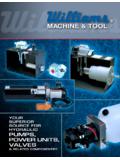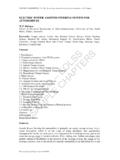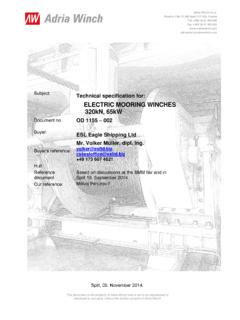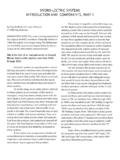Transcription of BASIC HYDRAULIC THEORY
1 BASIC HYDRAULIC THEORY The basis for all HYDRAULIC systems is expressed by Pascal's law which states the pressure exerted anywhere upon an enclosed liquid is transmitted undiminished, in all directions, to the interior of the container. This principle allows large forces to be generated with relatively little effort. A 5-pound force exerted against a 1-inch square area creates an internal pressure of 5 psi. This pressure, acting against the 10 square inch area develops 50 pounds of force. In a BASIC HYDRAULIC circuit, the force exerted by a cylinder is dependent upon the cylinder bore size and the pump pressure.
2 (There is no force generated unless there is resistance to the movement of the piston). With 1000 psi pump pressure exerted against a 12 square inch piston area (approximately 4" dia.), a force of 12,000 pounds is developed by the cylinder. The speed at which the piston will move is dependent upon the flow rate (gpm) from the pump and the cylinder area. Hence, if pump delivery is 1 gallon per minute (231 ) the cylinder piston will move at a rate of 20 (231 ). The simplest HYDRAULIC circuit consists of a reservoir, pump, relief valve, 3-way directional control valve, single acting cylinder, connectors and lines.
3 This system is used where the cylinder piston is returned by mechanical force. With the control valve in neutral, pump flow passes through the valve and back to the reservoir. With the valve shifted, oil is directed to the piston side of the cylinder, causing the piston to move, extending the rod. If the valve is returned to neutral, the oil is trapped in the cylinder, holding it in a fixed position, while the pump flow is returned to the reservoir. Shifting the valve in the opposite direction permits the oil to pass through the valve back to the reservoir.
4 The relief valve limits the system pressure to a pre-set amount. A HYDRAULIC system using a double acting cylinder and a 4-way valve differs from the single acting cylinder system in that the cylinder can exert force in both directions. With the control valve in neutral, flow is returned to the reservoir. When shifted in one direction, oil is directed to the piston side of the cylinder, causing the cylinder to extend. Oil from the rod side passes through the valve back to the reservoir. If the valve is shifted to neutral, oil in the cylinder is trapped, holding it in a fixed position.
5 When the valve is shifted in the opposite position, oil is directed to the rod side of the cylinder, causing the cylinder to retract. Oil from the piston side passes through the valve back to the reservoir. Cylinder extend force is a result of the pressure (psi) times the piston area. Retract force is a result of the pressure (psi) times the area difference between the piston minus the rod diameter. Rotary HYDRAULIC motor circuits are basically the same as cylinder circuits. Systems may be uni-directional or bi-directional.
6 The amount of rotary force (torque) available from the motor is a function of pressure (psi) and motor size. Speed is a function of flow and motor size. All the systems described above are open center systems due to the oil flowing through the control valve back to tank. Most systems are this type. Closed center systems use control valves with the inlet port blocked and variable displacement pumps. With the control valve in neutral, the pump is de-stroked to zero flow. Standard Vertical power Units Standard vertical HYDRAULIC power units offer standard systems complete with: Reservoir, Gear pump, Pump motor adapter, 1800 RPM TEFC electric motor, Flexible coupling, Pressure control relief valve, Suction strainer.
7 Pressure gauge, Air breather/filler assembly, Sight gauge w/thermometer, Drain plug Pressure and return connections, Return line filter. Noise levels below 90db. All units include operation manuals. Optional Accessories Include: Aluminum parallel or series directional control manifolds with/without cartridge relief valve in D03 and D05 sizes with AC, DC, or pilot Pressure and flow control modular valves in D03 and D05 sizes. Oil coolers available in air and water designs. How to come up with a part Step 1 Pump / Motor Selection HP | GPM 1 GPM GPM 5 GPM 7 GPM 10 GPM 12 GPM 1 HP 1 PHASE 1S1 1S3 1S5 1S7 1 HP 3 PHASE 1T1 1T3 1T5 1T7 3 HP 1 PHASE 3S1 3S3 3S5 3S7 3S10 3 HP 3 PHASE 3T1 3T3 3T5 3T7 3T10 5 HP 1 PHASE 5S1 5S3 5S5 5S7
8 5S10 5S12 5 HP 3 PHASE 5T1 5T3 5T5 5T7 5T10 5T12 HP 1 PHASE 7S3 7S5 7S7 7S10 7S12 HP 3 PHASE 7T3 7T5 7T7 7T10 7T12 10 HP 1 PHASE 10S5 10S7 10S10 10S12 10 HP 3 PHASE 10T5 10T7 10T10 10T12 Note: Maximum operating pressure = (1714 x HP / FLOW) *.
9 85 Step 2 Reservoir Selection Size 3 gal. 5 gal. 10 gal. 20 gal. 30 gal. Code A B C D E Note: Typical systems require reservoirs equal to times the flow rate. Capacity Gallons A B C D1 D2 E F 3 12 10 11 10 10 10 5 10 12-1/2 14-1/2 13-1/2 10 12 10 12 16-1/2 19 17-1/2 14 16 20
10 24 16-1/2 19 17-1/2 14 16 30 36 16-1/2 19 17-1/2 14 16 Step 3 Options Options Air Cooler Water Cooler Relief valve Priority Flow Control Code V W X Y * Place options in alphabetical Step 4 Manifold Size / Style Series Parallel D03 F G D05 H I Step 5 Number of Manifold Stations Number of Stations 1 to 4 ?





